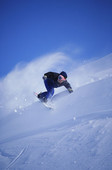Helmets Save Lives in Winter Sports
Snow activities boost head injury risk, but experts say precautions can keep you safe.
|
E-mail this article
Subscribe to news
Printer friendly version
|

(SOURCE: American Association of Neurological Surgeons, news release, January 2008)
SATURDAY, Jan. 12 (HealthDay News) -- Every year, thousands of children and adults are treated at U.S. emergency rooms for head injuries related to the pursuit of winter sports.
However, wearing a helmet and taking other precautions can protect you and your family, says the American Association of Neurological Surgeons (AANS).
Here are the most recent (2006) winter sports-related head injury statistics from the U.S. Consumer Product Safety Commission: snowboarding, 6,326; hockey, 5,263; skiing, 4,922; skating, 2,924; sleds, snow discs and toboggans, 2,142; snowmobiles, 301.
Skiing and snowmobiling accidents are the most common causes of serious head injuries and head injury deaths.
The AANS offers simple safety tips that help reduce the risk of such head injuries:
- Purchase and always use sport-specific helmets or protective head gear approved by ASTM International, one of the largest voluntary standards development organizations in the world.
- Wear appropriate clothing for the sport.
- Don't participate in sports when you're ill, tired or have consumed alcohol.
- Don't participate in sports when weather conditions pose a hazard.
- Be cautious when driving snowmobiles and stay on marked trails.
- Skate only in designated areas, and check the ice for cracks and debris.
- Use only sleds that can be steered. Never go down a slope head first.
- Obey all posted signs and warnings on ski slopes, sledding hills and skating rinks.
More information
The U.S. National Library of Medicine has more about head injuries.
Copyright © 2008 ScoutNews, LLC. All rights reserved. 
HealthDayNews articles are derived from various sources and do not reflect federal policy. healthfinder.gov does not endorse opinions, products, or services that may appear in news stories. For more information on health topics in the news, visit the healthfinder.gov health library.